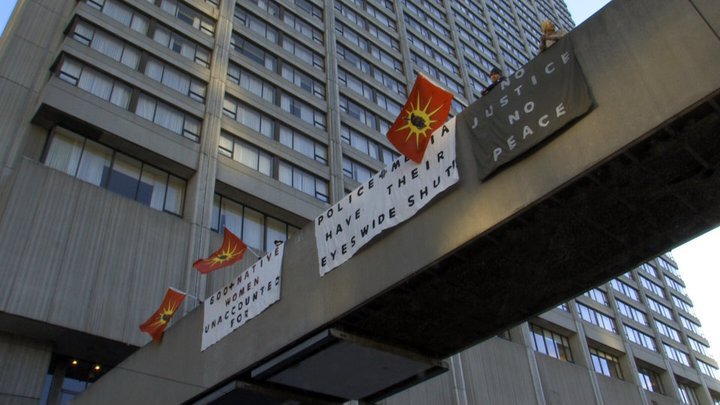On Nov. 1, 2010, members of Sisters and Brothers in Solidarity (SBIS) and Red Power United (RPU) held a vigil for murdered and missing Indigenous women on an pedestrian overpass at Toronto City Hall that crosses over Queen Street West.
The vigil was called to direct the public’s and media attention to the pervasive crisis facing Indigenous women in Canada.
Banners dropped included the messages: “600+ Murdered Women Unaccounted For” and “We Want Government Accountability. Stop Hiding!!” The group of 15 activists spent almost two hours on the pedestrian overpass singing sacred songs and drumming until forced to leave by Sheraton Hotel security guards acting through the Toronto Police.
According to a statement from Red Power United, “Native women have long struggled to draw attention to violence within their own families and communities. Canadian police and public officials have also long been aware of a pattern of racist violence against Native women in Canadian cities – but have done little to prevent it.
The list of missing and murdered Native women in Canada grows: Out a total of 582 cases, 393 died as a result of murder or negligence. And 115 remain missing. Only 53% of the cases involving Native women was someone charged, whereas the average rate for charges in a homicide in Canada is 84%.
While official accounting of the dead places the number at 500+ I believe the actual number of murdered and missing (perhaps this word only describes bodies that have yet to be found) Indigenous women at over 1,000.
According to a press release by SBIS concerning the disappearances and murders, “First Nations communities across Canada have been carrying the burden of this sadness for generations as they have walked this trail of grief. They are stepping out of the shadows and coming forward to tell the truth.
According to the Native Women’s Association of Canada (NWAC), “Aboriginal women and girls are facing the most pervasive human rights crisis in Canada today. As of March 31st 2010 NWAC has found 582 cases of missing and murdered Aboriginal women and girls.”
While the Canadian public may not be (or show) concerned about this issue, last year, the United Nations Committee on the Elimination of Discrimination against Women issued the statement: “Hundreds of cases involving aboriginal women who have gone missing or been murdered in the past two decades have neither been fully investigated nor attracted priority attention.”
Before you get too excited about the government’s long awaited announcement of a $10 million dollar national strategy to deal with the problem of murdered and missing Indigenous women, please read this rabble.ca article: Sisters in Spirit program used by feds to ‘squeeze’ Native Women’s Association of Canada
I will note that the government’s national strategy includes the promise (and we all know how much currency a government promises carries) for a national police support centre for missing persons and unidentified remains that won’t be operational until perhaps 2013? The new centre will rely on missing persons reports filed with local police forces. It will provide linkages to other cases if they exist (what about complaints of racism and the charge that local police officers ignore or do not follow up on these missing persons reports?)
The problem extends its killing silence across the country. We need to look no further than the province of British Columbia with its infamous Highway of Tears.
Highway 16 is the British Columbia, Canada, section of the Yellowhead Highway.
Since 1969, at least 32 women, many of them aboriginal, have been killed or suspiciously disappeared along the 800-kilometre (500-mile) section of highway between Prince George and Prince Rupert.
On October 2007, Project E-Pana, an investigation by the RCMP (Royal Canadian Mounted Police) examining the similarities between these murders and disappearances determined that 18 of them show enough similarities to be linked. These are the unsolved murders and missing-persons files that are collectively called “The Highway of Tears” case.
[There is a new website titled I Am Missing to assist in the search.]
Two weeks ago, the two activist groups held a 200 person demonstration through the streets of Toronto on Oct. 4, 2010. You can read about it here.
If you have a Facebook account, you can view the photos of Monday’s action here.




